We are so grateful to Newfoundland and Labrador Tourism for making this adventure possible. As always, all opinions are our own.

Almost as an afterthought to our two weeks in Newfoundland we decided to spend our last night on the far southern tip of the island at to visit Cape St. Mary’s Ecological Reserve.
Several of the incredibly friendly folks we’d met along our journey had recommended a stop at the ecological reserve out on this lonely point. They all guaranteed that we’d see birds, lots of birds… and maybe even puffins.

But as we made our way down the incredibly steep, winding road leading to the cape the idea was starting to seem a little bird brained.
Then the fog rolled in and we were fairly convinced that nothing could be worth driving through such pea soup.
We should have just stayed in Argentia and waited for the ferry back to the mainland the next day.

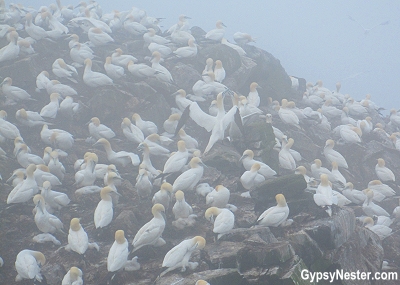
But we had gone too far to turn back so we drove blindly, very slowly, down the tiny road leading to the reserve.
Boy are we glad we did!
Even through the murky mist the sight and sound of thousands upon thousands of birds clinging to a cliff was well worth our effort.
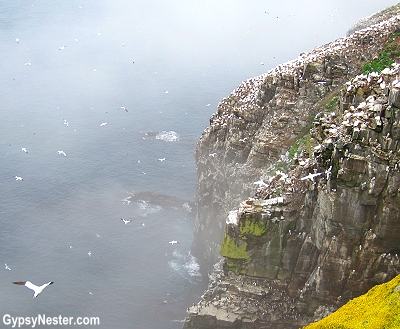
By the time we walked back the half mile trail from bird rock to the interpretive centre we were soaked to the skin from the thick vapor.
After shaking it off like wet dogs we had a chat with the resident ranger.
We were extremely excited by what we had been able to see and since we were staying the night we asked what the chances of a clear day in the morning might be.
He explained that this sort of weather was the norm, over two hundred days a year the cape is socked in. The nearby fog horn we heard wailing must really get a work out.

See all the exciting food (and drink) we found in Newfoundland!
But then he offered a couple of what turned out to be great suggestions.
Try coming back in the morning because sometimes the fog comes and goes – offering an occasional clear view.
And try the Gannet’s Nest restaurant by the RV park for the best fish & chips in Newfoundland.

He was most certainly right about the restaurant, fantastic fresh, crispy, lightly breaded fish right out of the nearby water.
Plus, they had something we had never seen before and doubt we will ever again, Bottle Moose.
Several problems with that leapt to our minds. First and foremost, we are fairly certain that moose don’t actually exist.
Even if they did, they would never fit into a bottle.
With that cleared up we discussed the local dialect. We had noticed when we stopped for gas in St. Brides, the nearest town, that the accent sounded like it was straight out of Scotland. So while we ate we listened in on some of the chatter around the room. Once our fish was devoured, Veronica decided to talk to some of the patrons and see if they would teach her some of the lingo.
WATCH: Meet our amazing tutors!
We did learn some new phrases, had more than our share of hearty laughter, and got an invite to stay the night. This was right in keeping with our experiences throughout Newfoundland, the nicest people anywhere.

At daybreak the next morning the fog had lifted, so we frantically broke camp and made our way to the reserve.
Our hopes were sky high until we got near the coast and the fog began to roll in again.
Discouraged, we still decided to give the birds another look, and as we approached the cliffs a magical thing took place. The clouds parted and revealed a truly awesome sight.
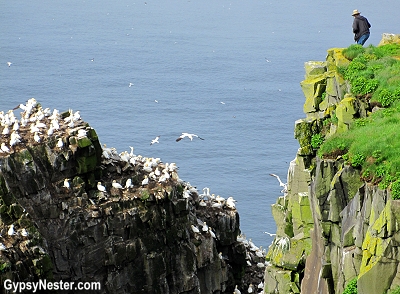
Seeing clearly what was so thickly shrouded the day before was actually shocking. We had not seen even a quarter of the birds nesting along the sheer rock walls.
We also had no idea how far the drop-off down to the ocean was, or how close to the edge we had been. There is a huge canyon with vertical sides that fall more than thirty stories straight down to the sea.
WATCH: SOOOO many birds!


With visibility restored, we could see how the colony consists of many different species of birds.
The free-standing, island mountain in the middle, known as Bird Rock, is completely covered by gannets. Northern gannets to be precise, around twenty thousand of them.
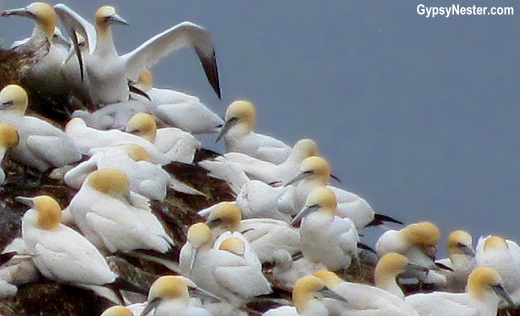
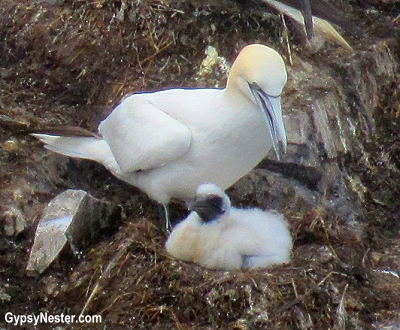
Laying on the ground to get as close to the edge as possible, we were able to spot a few chicks peeking out of the nests.
The mating pairs each have one egg that they take turns incubating, and then feeding the hatchling.
See all of our Newfoundland adventures!

We also noticed that gannets look a lot like the blue-footed boobies we saw in The Galapagos Islands.
There’s a good reason for that, turns out they are closely related to boobies.


The cliffs on either side of Bird Rock are covered with innumerable other birds.
There are about as many of both black-legged kittiwakes and common murres as there are gannets.
All in all, well over fifty thousand birds. Between the drifting fog banks we got good views of most of them.

The kittiwakes, members of the gull family, tend to occupy the highest ground, while several types of auks: the common murre, thick-billed murre, and razorbill, nest closer to the water.
The auks look for all the world like penguins, but they can fly… barely.

We were highly entertained watching them frantically flapping their stubby wings attempting to get airborne. Jumping off the cliffs worked much better, still they would drop like a rock for a few moments before moving enough air to take flight.

Cormorants and a few black guillemot can also be spotted along the rocks, but the hit and miss fog was beginning to hit more than miss, and our time was running low, so we made our way back to the interpretive centre.
This was where we finally spotted a puffin.
Unfortunately, not of the live variety.
That will just have to wait until we can return to this amazing place known as Newfoundland.
David & Veronica, GypsyNester.com
See all of our Newfoundland adventures!
We are so grateful to Newfoundland and Labrador Tourism for making this adventure possible. As always, all opinions are our own.



Great read! We’re trying to decide what to do before we take the ferry from Argentia and it seems like the drive south is worthwhile!
Oh it is definitely worth the drive. Don’t watch Hitchcock’s The Birds before you go though.
It seems like you’re ended up having a wonder time with the birds. Thanks for sharing, you got me inspired here. Keep it up. Good luck.
Thanks Nika!
I have never heard our dialect being referred to as sounding Scottish. The majority of Newfoundlanders are Irish. Glad you enjoyed your stay. I am from Placentia, just next to Argentia where you caught the boat. Cheers!
To be fair, it was only in the area around St. Mary’s that the accent sounded Scottish. We loved all of Newfoundland.
That is seriously an insane amount of birds! Thank you for going out on the ledge (literally!) to capture these amazing images for us.
It was unbelievable! 😉
So many birds!!!! I wonder if this place inspired Hitchcock.
Felt a little like the movie at times. 😉
Stunning photos! That plate of fish and chips makes me miss my home in Atlantic Canada 🙂
Thanks Frank, you come from a great place.
So much fun. Love your “language learning” video! The birds are gorgeous…what a great time.
Thanks Corinne! We never did master the language. 😉
I’m glad it ended up being a nice trip for you two! The flock of birds make it worth it! The food looks delicious, too. Thanks for sharing!
As always, our pleasure!
I love your end comment you finally saw a Puffin, though not a live one, lol.